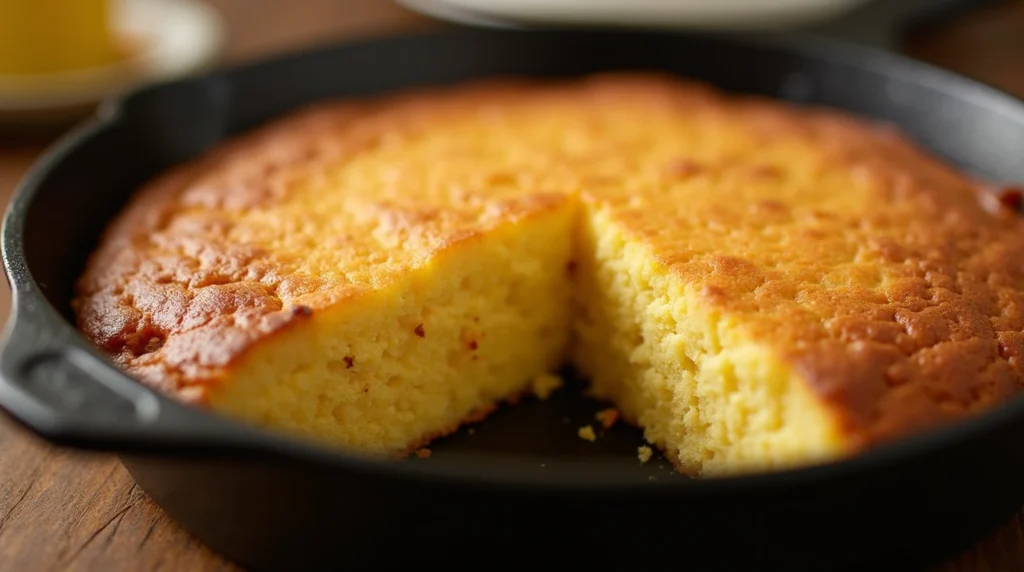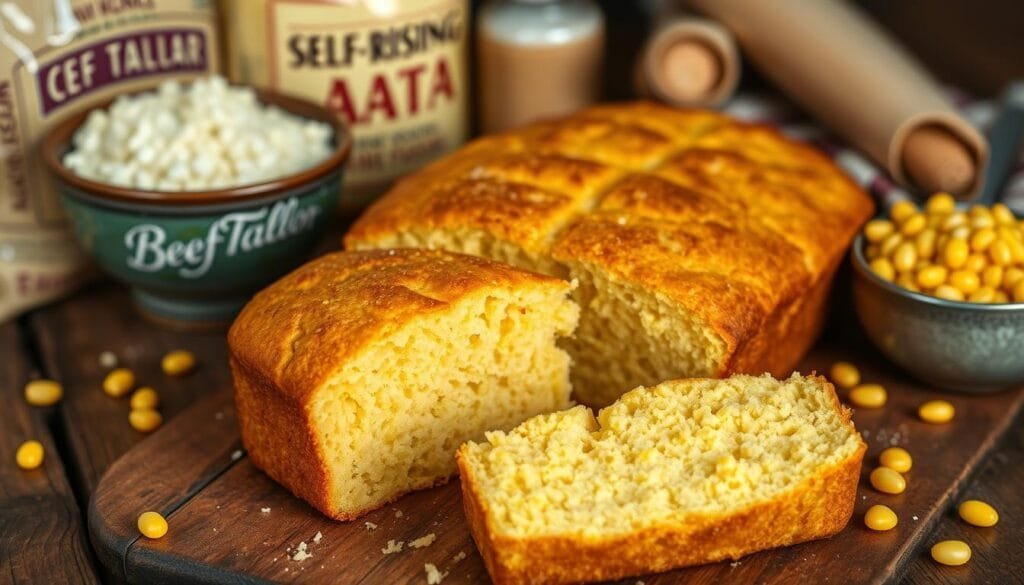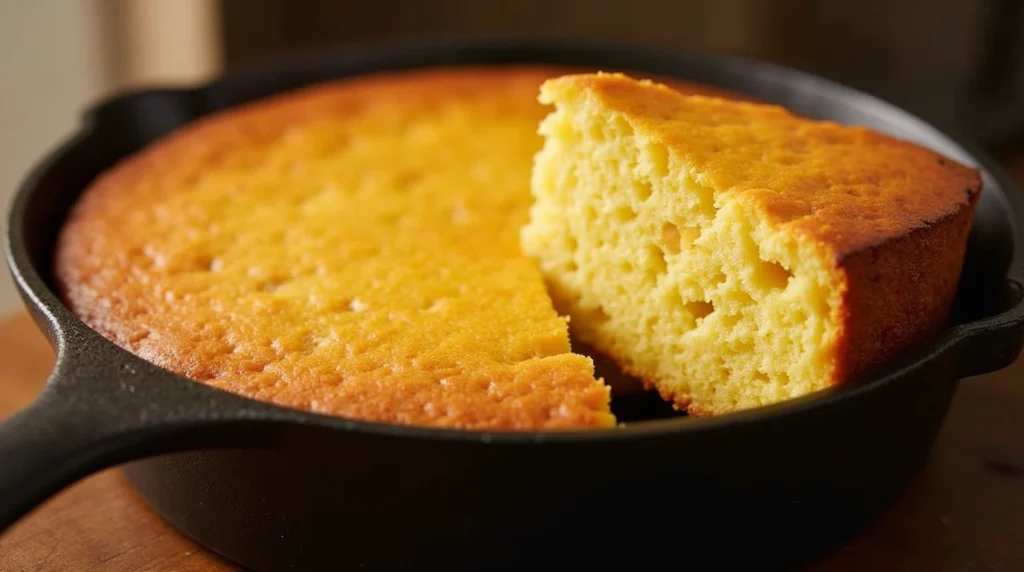Experience the true taste of the American South with this southern cornbread recipe. It’s made with beef tallow, adding a rich and savory flavor. Baked in a cast iron skillet, it captures the essence of Southern cooking.
Learn how beef tallow creates the cornbread’s crispy crust and delicious texture. This makes it a standout dish in Southern cuisine.
Table of Contents
Key Takeaways
- Explore the heritage and history of southern cornbread made with beef tallow in a cast iron skillet
- Understand the importance of using beef tallow for enhanced flavor and texture
- Learn the essential ingredients and step-by-step guide for preparing the perfect southern cornbread
- Discover tips and techniques for mastering the cast iron skillet method
- Understand common mistakes to avoid and explore regional variations of this classic dish
The Heritage of Southern Cast Iron Cornbread
The history of southern cornbread goes back centuries. It started with Native American tribes and early European settlers. Today, it’s still made with cast iron skillets and beef tallow, keeping true to southern cooking traditions.
Origins in Southern American Cuisine
Cornbread has been a key part of southern American food for ages. It began with Native American tribes like the Cherokee and Choctaw. They ground corn into meal and baked it in clay or stone ovens.
When European settlers came, they kept this tradition alive. They often baked cornbread in cast iron skillets over open fires.
Traditional Cooking Methods
Cast iron skillets are essential for making southern cornbread. These pans have been used for generations. They help make the cornbread’s crust golden and the inside fluffy.
The cast iron’s heat retention and seasoning make it perfect for cooking cornbread. It ensures the dish turns out right every time.
Why Beef Tallow Matters
Beef tallow is a key ingredient in southern cooking, including cornbread. It adds flavor and texture to the dish. The tallow’s high smoke point helps create a crispy crust.
Its rich taste also complements the cornmeal’s sweetness. This makes the cornbread even more delicious.

The legacy of southern cast iron cornbread shows the region’s rich food history. It connects us to Native American roots and modern kitchens. This dish remains a cherished part of southern culture and food.
Essential Ingredients for Perfect Southern Cornbread
Making the perfect Southern cornbread needs a few key ingredients. These ingredients work together to give the cornbread its unique texture and taste. At the core are self-rising cornmeal, self-rising flour, and a secret ingredient – beef tallow.
Self-rising cornmeal is the base, offering a coarse texture that’s key to authentic Southern cornbread. It has baking powder and salt, making the cornbread light and fluffy. Self-rising flour adds softness and structure to the mix.
Beef tallow is a must for Southern cornbread. It’s a fat made from beef suet, adding a rich flavor and a golden-brown crust. The mix of cornmeal, flour, and beef tallow makes the cornbread both rustic and refined.
Buttermilk and eggs are also crucial. Buttermilk adds a tang and helps the leavening agents work. Eggs bring moisture and richness to the cornbread’s texture.
| Ingredient | Purpose |
|---|---|
| Self-rising cornmeal | Provides the signature coarse, grainy texture |
| Self-rising flour | Lends softness and structure to the batter |
| Beef tallow | Imparts rich flavor and a tender, golden-brown crust |
| Buttermilk | Adds a subtle tang and helps to activate the leavening agents |
| Eggs | Contribute moisture and richness to the final texture |
By choosing and mixing these essential ingredients, you can make a Southern cornbread that’s both comforting and delicious.

Why Beef Tallow Makes the Best Southern Cornbread
Beef tallow is the secret to the perfect Southern cornbread. It’s a traditional fat that has been used for generations. It adds flavor and texture that’s unmatched.
Flavor Enhancement Properties
Beef tallow brings a rich, savory flavor to cornbread. It’s different from other fats like vegetable oil or butter. This makes the cornbread taste comforting and indulgent, truly capturing Southern cuisine’s essence.
Texture Benefits
Beef tallow also changes the cornbread’s texture. It makes the crust crisp and golden while keeping the inside moist. This creates a cornbread that’s both satisfying and delightful.
Historical Significance
Using beef tallow in cornbread is more than a preference. It’s a tradition that goes back to the South’s agrarian past. It’s a way to honor the South’s culinary heritage by making a delicious dish.
“Beef tallow is the secret ingredient that makes Southern cornbread truly exceptional. Its unique flavor and texture-enhancing properties are unparalleled.”
Southern Cornbread Recipe Beef Tallow: Step-by-Step Guide
Making southern cornbread with beef tallow is a cherished tradition. It creates a golden-brown crust and a moist, flavorful crumb. Follow this guide to make this classic dish in your kitchen.
First, heat your cast iron skillet over medium-high. Add a generous tablespoon of beef tallow. Let it melt and coat the skillet. This step helps your cornbread get a crisp exterior.
- In a large mixing bowl, combine 1 cup of self-rising cornmeal, 1/2 cup of all-purpose flour, 1 tablespoon of sugar, and 1 teaspoon of salt.
- Whisk together 1 cup of buttermilk, 2 large eggs, and 2 tablespoons of melted beef tallow until well blended.
- Gently fold the wet ingredients into the dry ingredients, being careful not to overmix. The batter should have a slightly lumpy, pourable consistency.
- Carefully pour the batter into the preheated cast iron skillet, spreading it evenly to the edges.
- Bake in a 400°F oven for 20-25 minutes, or until a toothpick inserted into the center comes out clean and the top is golden brown.
Beef tallow is key to perfect southern cornbread. It adds richness and flavor. The cast iron skillet also helps, creating a crisp crust and a tender interior.
“The secret to southern cornbread is in the tallow – it’s what gives it that signature flavor and texture that you just can’t replicate with any other fat.”
Quality ingredients are crucial. Use the best self-rising cornmeal, fresh buttermilk, and high-quality beef tallow. With practice, you’ll make perfect southern cornbread.

Mastering the Cast Iron Skillet Technique
Mastering the cast iron skillet is key to perfect southern cornbread. The right preheating, temperature control, and seasoning make a big difference. They help achieve a crispy crust and a moist, flavorful inside.
Preheating Methods
To get your skillet ready, preheat it well. Put the empty skillet in the oven and heat it for 15-20 minutes at 400-450°F. This ensures even heat for a beautifully baked cornbread.
Temperature Control Tips
- Keep the oven temperature steady. Don’t open the oven door too often to avoid temperature changes.
- Use an oven thermometer to check the temperature and adjust as needed.
- Invest in a cast iron oven mitt for safe handling of the hot skillet.
Seasoning Your Skillet
A seasoned cast iron skillet is essential for great southern cornbread. Seasoning involves coating the skillet with oil and baking it at high heat. This creates a non-stick surface. Repeat this process often to keep the skillet in top shape and prevent rust.
| Seasoning Tips | Benefits |
|---|---|
| Use a high-heat stable oil like vegetable, canola, or peanut oil | Creates a durable, non-stick surface |
| Bake the oiled skillet at 400°F for at least 1 hour | Allows the oil to polymerize and bond to the cast iron |
| Repeat the seasoning process periodically | Maintains the skillet’s non-stick properties and prevents rust |
Mastering the cast iron skillet technique is crucial for perfect southern cornbread. Focus on proper preheating, temperature control, and seasoning. This will give you a crispy crust and a tender, flavorful interior.

Common Mistakes to Avoid When Making Cornbread
Making the perfect southern cornbread recipe needs careful attention. Stay away from these common mistakes to make sure your cornbread is always perfect.
Overmixing the Batter
One big mistake is overmixing the batter. This can make the cornbread dense and tough. Just mix the ingredients until they’re combined, without overworking the dough.
Incorrect Ingredient Ratios
Getting the right mix of cornbread with self rising flour or cornbread with self rising cornmeal is key. Pay attention to the recipe’s measurements to get the right consistency.
Improper Skillet Preparation
Not preheating and seasoning your cast iron skillet right can stop the cornbread from getting a crispy crust. Follow the tips for preheating and seasoning your skillet from the previous section.
By avoiding these mistakes, you’ll be on your way to baking the most delicious southern cornbread recipe every time.
Variations and Regional Adaptations
The beauty of southern cornbread lies in its regional diversity. The classic recipe with beef tallow is loved by many. But, home cooks across the South have added their own twist. They’ve made it sweet or savory, exploring local culinary traditions.
Sweet vs. Savory Options
In some areas, people like their cornbread sweeter. They add honey, molasses, or fresh corn kernels. This makes the bread taste like a dessert. Others prefer it savory, with cheese, jalapeños, or bacon for a richer flavor.
Modern Twists on Traditional Recipe
Home cooks have made southern cornbread their own. They’ve added unique spices and herbs. They’ve also tried different flours, like whole wheat or gluten-free. Some have even turned it into cornbread muffins or waffles, giving it a new twist.
| Regional Variation | Flavor Profile | Distinctive Ingredients |
|---|---|---|
| Texas-Style Cornbread | Savory and Spicy | Jalapeños, Cheddar Cheese |
| North Carolina Cornbread | Sweet and Moist | Honey, Creamed Corn |
| Appalachian Cornbread | Hearty and Rustic | Buttermilk, Bacon Grease |
Whether you love the classic southern cornbread recipe or want to try something new, there’s a lot to explore. From sweet cornbread to savory cornbread, there’s something for everyone. It’s a way to celebrate the South’s rich culinary heritage.
Storing and Reheating Your Cornbread
Keeping your southern cornbread fresh is key. Whether you have leftovers or a full pan, the right storage and reheating can make every bite delicious, even days later.
Storing Cornbread for Maximum Freshness
To keep your cornbread tasting great, follow these easy storage tips:
- Let the cornbread cool down completely before storing.
- Wrap it tightly in plastic wrap or aluminum foil, making sure there are no air pockets.
- For the best taste, store it at room temperature for up to 3 days.
- If you need to keep it longer, refrigerate it for up to 1 week.
Reheating Cornbread: Restoring Warm, Crisp Perfection
To enjoy your stored cornbread, follow these easy reheating steps:
- Preheat your oven to 350°F (175°C).
- Put the wrapped cornbread on the oven rack or a baking sheet.
- Reheat for 10-15 minutes, until it’s warm and crisp.
- Serve it right away for the best taste and texture.
For a special treat, brush the cornbread with melted butter or drizzle with honey before serving.
Freezing and Thawing Cornbread
To enjoy your cornbread even longer, you can freeze it:
- Wrap the cooled cornbread tightly in plastic wrap or aluminum foil.
- Put the wrapped cornbread in a resealable freezer bag or airtight container.
- Freeze it for up to 3 months.
- To thaw, put it in the fridge overnight.
- Reheat the thawed cornbread in the oven as described above.
By using these simple storage and reheating tips, you can enjoy your homemade southern cornbread for days.

Conclusion
In the world of Southern cuisine, the southern cornbread recipe beef tallow is a timeless classic. It’s rooted in the rich heritage of traditional cooking methods. By baking cornbread in a cast iron skillet with beef tallow, you’ve found the true essence of this beloved dish.
This recipe has a long history in the American South. It offers texture and taste benefits from beef tallow. It’s a true reflection of traditional cooking and the cultural significance of the cast iron skillet. Mastering the technique and avoiding common mistakes are key to making perfect Southern cornbread every time.
We encourage you to try this timeless recipe and explore regional variations. Discover the diverse flavors and textures that make Southern cornbread a true culinary delight. Whether you serve it with barbecue, use it for a stew, or enjoy it alone, this southern cornbread recipe beef tallow will become a cherished part of your cooking. It connects you to the rich tapestry of Southern food traditions.
FAQ
What is the significance of using beef tallow in a southern cornbread recipe?
Beef tallow has been a key ingredient in southern cooking for ages. It adds a rich, savory taste. It also makes the cornbread’s crust crisp when baked in a cast iron skillet.
Why is it important to use a cast iron skillet when making southern cornbread?
A cast iron skillet is crucial for the perfect southern cornbread. It cooks evenly and creates a signature crust. The skillet’s heavy, heat-retaining properties are key.
What are the key ingredients needed for a traditional southern cornbread recipe?
Essential ingredients include self-rising cornmeal, self-rising flour, buttermilk, eggs, and beef tallow. Together, they offer the right mix of moisture, texture, and flavor.
How does the use of beef tallow enhance the flavor and texture of southern cornbread?
Beef tallow brings a deep, savory flavor to the cornbread. It also makes the crust crisp and the inside tender. This is thanks to its high smoke point and how it coats the cornmeal.
What are some common mistakes to avoid when making southern cornbread?
Common mistakes include overmixing the batter and using the wrong ingredient ratios. Not preheating the skillet properly is also a mistake. These errors can ruin the cornbread’s texture and flavor.
Can I make variations on the traditional southern cornbread recipe?
Yes! You can try sweet or savory twists, like adding cheese or jalapeños. These changes can give the classic cornbread a new flavor.
How should I store and reheat leftover southern cornbread?
Store leftover cornbread in an airtight container at room temperature for up to 3 days. To reheat, warm slices in a preheated oven or toaster oven until crispy.



